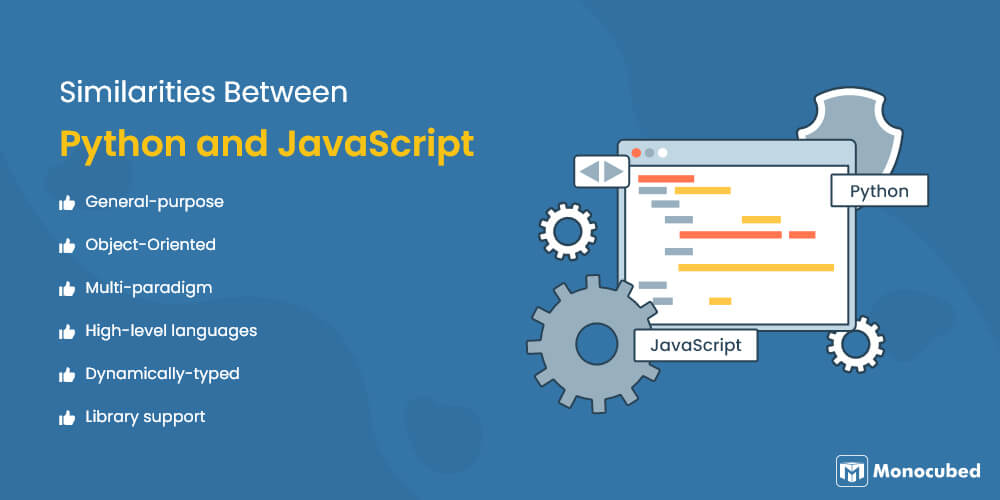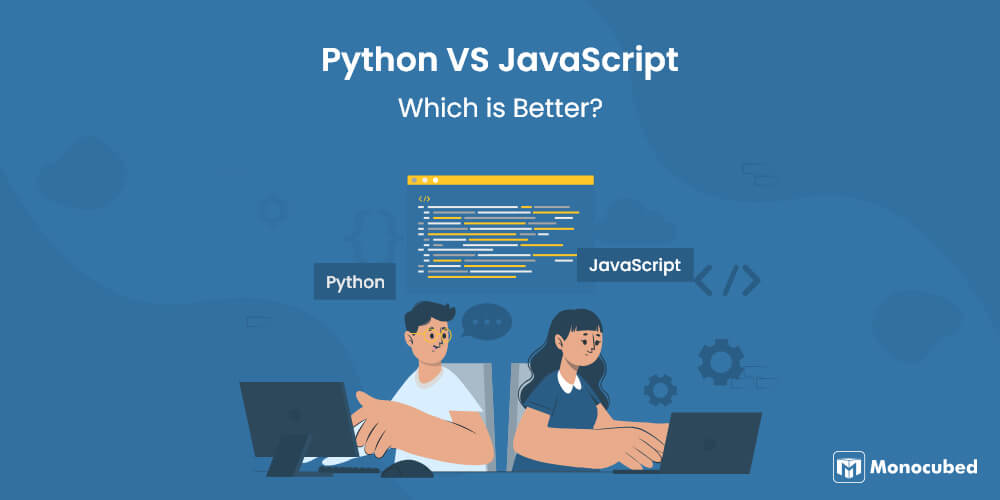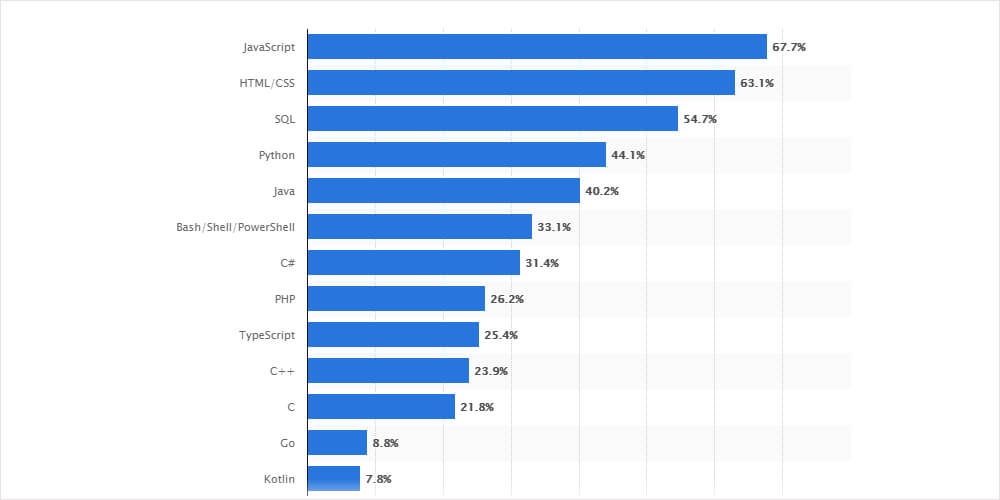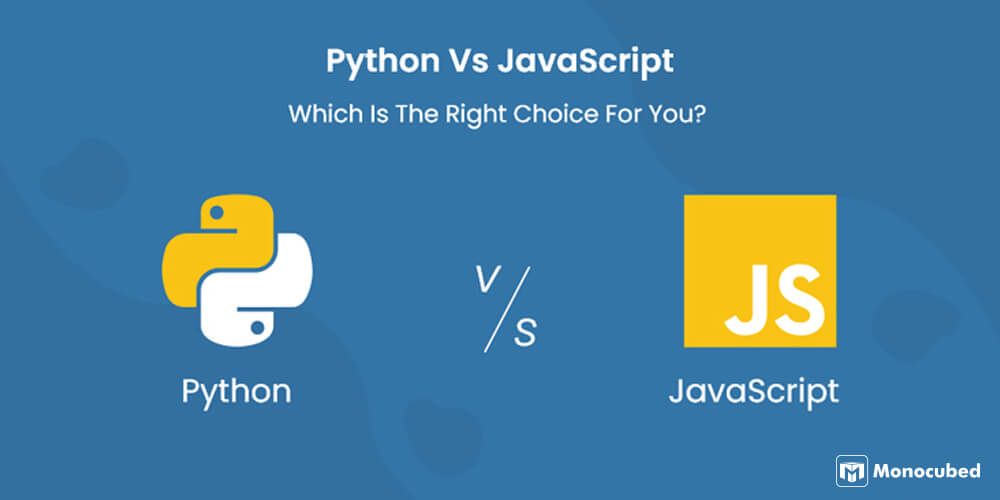Programming languages are the basis of the web development process. Selecting the perfect language is crucial for the efficient development of revenue-generating websites and web applications.
Python and JavaScript are two of the most popular programming languages used for web application development. But this raises the question of Python Vs JavaScript. Which is the right choice for you and your team?
Don’t worry! We have curated a head-to-head comparison of Python and JavaScript, comparing their similarities and differences to decide once and for all the superior language. We have listed down all the criteria that will help you make the right decision.
We will also be looking at all the Python and JavaScript features that make them such widely-beloved languages. Along with that, we list reasons why you should use them for your next web project.
But before we go on the Python VS JavaScript comparison battle, let us first briefly introduce both JavaScript and Python.
Table of Content
- A Brief Glance At JavaScript
- A Brief Glance At Python
- Are There Any Similarities Between Python and JavaScript?
- Python Vs JavaScript: A Head-to-Head Comparison
- Pros and Cons of Using JavaScript Language
- Pros and Cons of Using Python Language
- Which is the Right Choice: Python or JavaScript?
- FAQs
- Conclusion
A Brief Glance At JavaScript
JavaScript is a scripting language mainly used for developing dynamic web pages. Standardized using the ECMAScript language specification, it is one of the backbones of the World Wide Web. But JavaScript is also an object-oriented programming language that supports web browsers, web servers, game applications, and much more.
Widely used front-end technologies, such as jQuery, React, Angular 2, and Ember are developed on JavaScript. At the same time, JavaScript also serves as the basis of many popular backend development technologies, such as NodeJS, Express, MongoDB and Meteor.
JavaScript is the only scripting language native to all web browsers. It is no brain-teaser why it would be preferred by a web developer, frontend and backend alike. Now that we understand what JavaScript is, Python is the next stop. Let us look at some properties and features of Python.
A Brief Glance At Python
Python is an interpreted, high-level programming language that focuses on ease of use and accessibility. It is a general-purpose programming language that is used for developing small to large-scale applications. It features dynamic semantics, and a flexible language construct (syntax rules of a programming language), making it extremely easy to read and modify. Python is thus perfect for creating web applications.
Python is one of the most used object-oriented programming languages. It gives developers virtual objects that can be used as building blocks. Each object has its own sets of properties, such as shape, size, and type of behavior, that can be inherited and derived from each other.
Along with implementing OOP concepts, such as inheritance and data hiding, Python also uses the functional programming paradigm that binds the source code into independent mathematical style functions. This way Python, just like JavaScript, is a multi-paradigm language.
Python can also be used for writing scripts for web browsers. Its smooth learning curve and performance make it apt for quick prototyping and quick updates. It is also a top choice for data analysts and ML scientists for the robust libraries it offers.
Are There Any Similarities Between Python and JavaScript?

JavaScript and Python are popular programming languages that are used in multiple fields. Although they were originally designed for completely different purposes, with multiple updates throughout the years, JavaScript and Python have started including other functionalities to incorporate more general usage. Thus, they share a few similarities between them.
Some common features of both the languages are –
- General-purpose programming language – JavaScript and Python can be used across multiple domains from web development to software and API development.
- Object-Oriented – Both Python ad JavaScript use object-oriented programming concepts, such as inheritance, polymorphism, modularity, and data abstraction.
- Multi-paradigm – Both are multi-paradigm languages, supporting Object-oriented, procedural, functional (or declarative), and imperative programming paradigms.
- High-level languages
- Dynamically-typed
- Library support – Both languages have exceptionally developed library support. Python has Numpy, TensorFlow, and more, while a JavaScript developer can use React, Ionic, Meteor, and more.
Want to Develop a Custom Website?
Confused where to start? Don’t know how much it will cost? Wondering which platform to use for developing the website? We’ve got you covered. Let’s talk.
Python Vs JavaScript: A Head-to-Head Comparison
Now that we have a clear idea about both the languages, lets look at the major difference between Python and JavaScript.
| Factors | Python | Javascript |
|---|---|---|
| Type | Object-oriented programming language | Considered both programming and scripting languages |
| General Usage | It provides good support for Machine Learning, Data Analytics, math-intensive websites and applications | Used for native mobile, desktop and web applications. Hybrid and cross-platform application development is also supported |
| Usage in web development | Mainly used for backend development of websites and web apps | Used for designing the frontend of web pages |
| Numeric Data Types | Python has various numerical data types such as – Integer, Complex, and Floating-point | It has only floating-point for numerical data types. |
| Data Structures |
|
|
| Defining properties | Python uses getter and setter functions for defining an attribute | Attributes are used for defining properties of an object |
| Inheritance Model | Python has a class-based inheritance model | It uses prototypes for inheritance |
| Encoding Format | ASCII code encryption is used for Python files unless explicitly specified | The UTF-16 encoding format is used as it provides no support for byte manipulation |
| Data-conversion | Strongly typed – Allows no implicit data conversion | Weakly typed- Allows data conversion automatically |
| Modules | Batteries-included- has numerous modules and in-built libraries | Does not include too many modules |
| Libraries and Frameworks | Libraries like Numpy and Pygame provide code snippets for easy development. Flask, Django and CherryPy are some popular Python frameworks | Popular JavaScript libraries and frameworks used by a developer to write a script are ReactJS, Angular, Vue, EmberJS and more |
Before we end the Python VS JavaScript battle, let’s look at the advantages and disadvantages of using JavaScript and Python. It is essential to know the features of both languages before discussing what projects to use them for.
Pros and Cons of Using JavaScript Language
Advantages
Lets look at some of the advantages of JavaScript programming language –
1. Multi-purpose
JavaScript has implementations in multiple domains. JavaScript developers use Electron and Nw.JS framework for developing native desktop applications. React Native, one of the best mobile development tools, is used for developing mobile applications using JavaScript.
With the development of backend frameworks such as Node.JS, it is now also used as a basis for server-side scripting. Recently, there has been a lot of research going on in using JavaScript for IoT (Internet of Things) and implementing neural network algorithms in the data science field.
2. Multi-paradigm
JavaScript employs the three main styles of writing scripts- functional, procedural, and object-oriented. It is an object-oriented programming(OOP) language as it supports almost all the OOP concepts such as inheritance, data abstraction, and polymorphism. Almost every element of JavaScript is an object.
Along with this, JavaScript provides in-built functions to implement the best of both functional and procedural programming using React Hooks.
3. Uses Prototypes
JavaScript uses prototypes to implement object-oriented concepts of inheritance. Inheritance is deriving properties from another object.Unlike other coding languages that use class, JavaScript is a prototype-based programming language. You can implement many class functions using prototypes without worrying about classifying each object into a category right at the beginning of the JavaScript code.
4. Implements Async Processing
JavaScript Promise enables working with asynchronous requests. This means when a request is applied, JavaScript can immediately start processing it without waiting for a response. This speeds up the request processing.
With the release of EcmaScript 8, JavaScript also supports Async functions along with JS promises. With Async functions, you can process multiple function lines parallelly. Since the script does not need to be executed in order, the processing time for the code improves significantly.
Disadvantages
With so many pros, there are also some pitfalls to using JavaScript. Lets look at some of the disadvantages of JavaScript-
1. JavaScript has a complex structure
With numerous updates, there have been a lot of added features to the language. But the developers did not have consistency in their updates, and today plain JavaScript is a mess of conflicting syntax that is tough for developers to figure out.
Plus there are so many new frameworks and libraries being released that the market is very unstable. For companies that require stability, JavaScript is a chore to work with.
2. JavaScript DOM Manipulation can be slow
JavaScript is slower because of DOM manipulation. When a web page is loaded, the web browser creates a Document Object Model(DOM) based on the HTML code. DOM having a tree structure is used by JavaScript to add, modify or remove HTML elements, change CSS styles, and manipulate or create new events.
But, each modification requires refreshing the whole DOM tree. This significantly lowers the speed of JavaScript-based applications.
Pros and Cons of Using Python Language
Advantages
Why should you use Python? What are some advantages of Python programming language for web app development?
1. Fast and Highly Productive
Python is extremely fast and employs productivity-enhancing practices. You can do a lot more with fewer lines of code lines making it a great choice for quick prototyping. Python not only saves a lot of time but also reduces your company’s costs. That is why we prefer Python in our projects. Get Python web development services with us to save time and costs.
Comparing Python to JavaScript, JS can actually be much faster. So if your project requires good speed, you should go with JavaScript as Python can slow you down.
2. Easy To Use
Python is an extremely easy programming language to use. Using high-level keywords and simple, uncluttered syntax, Python offers readability and understandability.
If you are switching to Python, you will be able to grasp it quickly and start coding in a matter of days. With a huge online community, you can easily get solutions to any error or hindrance you might face.
3. Machine Learning and Data Sciences
Python has emerged as the best programming language for implementing Artificial Intelligence and Machine Learning paradigms. It offers a concise and simple coding environment for implementing complex ML algorithms.
Python also offers an extensive collection of libraries such as Pandas or Keras for Information Retrieval systems, Data Visualization, and Natural Language Processing. This can help you reduce coding time and develop reliable intelligent systems quickly.
Want to Integrate AI-ML Features in Your Web App?
Develop a full-featured web app with advanced ML and AI integration with our Python developers. Talk to us and start developing.
Disadvantages
Some drawbacks of using Python are-
1. Python web apps are slow
Python is an interpreted language, so you may find that it is comparatively slower than other popular languages. But Python can handle most websites and the speed is only an issue for time-intensive apps that require a huge memory.
2. Multi Threading not supported
One of the main issues for Python developers is it’s inability to support multi-threading. Python has this limitation because of the Global Interpreter Lock (GIL), a mutex that restricts the availability of resources for threads, allowing only one thread to execute at a time.
Since single-threaded programs are much slower in comparison, Python apps take a serious performance hit. Instead of multi-threading, you can implement multi-processes in Python. Multiprocessing will allow you to allocate separate resources to each process, but this can slow down your website.
3. Not suitable for Mobile App Development
Python is not native to the mobile environment. Although many tools can extend the functionalities of the language, many developers would prefer a better-suited coding language for developing native mobile apps. Moreover, Android and iOS technology don’t support Python as an official programming language.
Which is the Right Choice: Python or JavaScript?

As we have seen, Python and JavaScript are popular languages with numerous advantages to their name. According to this Statista survey, JavaScript is used by 67.7 % developers for web development, while Python is used by 44.4% web developers. So both programming languages are widely used.
But when looking at Python VS JavaScript for web development, popularity alone is not a useful criterion. It is important to look at all the advantages and disadvantages of both Python and JavaScript to decide which is most suitable for your project out of the two.

We suggest using JavaScript for projects that satisfy one or more of the following –
- Dynamic websites
- Cross-platform applications
- Mobile development
- Game app development
- Web servers
Python programming language on the other hand should be preferred when working with –
- Database driven apps
- Scalable applications
- Artificial Intelligence and Machine Learning
- Deep learning or Data Analysis
- Rapid prototyping
- Ad hoc programming
- GUI applications
- Neural Networks
In the Python VS JavaScript battle, there is no definite winner. Both Python and JavaScript have their own set of benefits and it is based on the project requirements that the right choice for you can be determined.
We hope this blog will assist you in making the right choice between Python VS JavaScript. You can also read our blog on What is Python Used For? to get more information.
Frequently Asked Questions
Is Python good for machine learning?
Machine Learning is a relatively new technology with a vast scope of implementation in numerous fields. With its simplicity, flexibility, and scalability, Python is a preferred programming language for ML. With access to extensive libraries, data scientists and programmers are able to perform math-intensive statistics and data analytics easily with Python code.
Is JavaScript easier to use than Python?
No. Python is much easier to use than JavaScript. It provides readable code and easier syntax while JavaScript has comparatively more complex structures and conceptual implementations.
Which websites uses Python and JavaScript?
Python and JavaScript together build a highly popular website. Most famous companies like Instagram, Google, YouTube, and Netflix use Python and JavaScript in their website and web app’s technology stack. The difference is that JavaScript is mainly employed for the frontend while Python is used for writing the server-side source code.
Conclusion
Python and JavaScript are the two giants of the development world. While JavaScript is the reigning king of frontend development, Python is an increasingly popular choice for implementing new technologies, such as Information Analysis and AI algorithms.
The difference between JavaScript and Python programming language lies in the functionality and usage. It is up to web developers like you to decide which is the right choice of language for the project.
Still juggling with Python VS JavaScript? Contact Monocubed for a free consultancy with our IT experts. In case you have any queries or questions, you can reach out to us at anytime, and we will provide the right web solution for you!
 By Jeel Patel
By Jeel Patel



